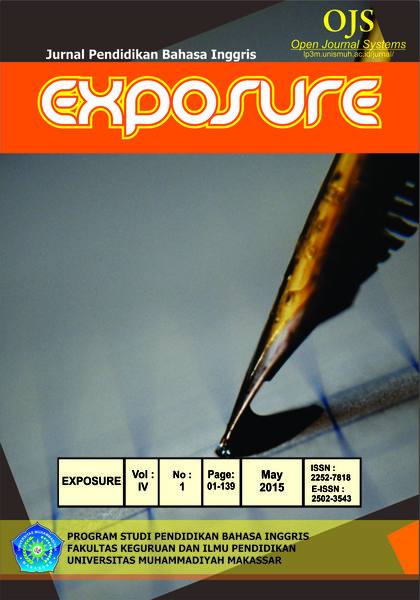THE EFFECTIVENESS OF BRAIN SKETCHING TECHNIQUE IN WRITING DESCRIPTIVE TEXT
DOI:
https://doi.org/10.26618/exposure.v4i1.918Abstrak
This research aimed to find out the students’ improvement in writing descriptive text especially in content and organization by using Brain Sketching Technique. The problem statement of this research was how is the use of Brain-Sketching Technique improved the students’ skill in writing descriptive text. The researcher used quasi experimental design, and used two classes they were experimental class and control class, the data was collected by using written test. The pre-test was given to the students’ to find out the students’ improvement in writing process before the treatment and the post-test was given to find out the students’ improvement in writing process after the treatment. The population was the second year students of SMP Aisyiyah Paccinongang that consisted of 20 students in academic year 2014/2015. Meanwhile, the sample of this research was taken by using purposive sampling. The research findings indicated that the achievement of the second year students of SMP Aisyiyah Paccinongang, Gowa, improved after the use of Brain-Sketching Technique. It proven by the mean score of pre-test in experimental class was 67.12 and post-test was 77.32 and the mean score of pre-test in controlled class was 68.12 and post-test was 74.37. The statistical computations showed that Brain-Sketching Technique was likely effective to improve the students’ writing in descriptive text.
Referensi
Arifin, Zainal. 2011. Penelitian Pendidikan. Metode dan Paradigma Baru. Bandung: PT. Remaja Rosda karya.
Bram, Barli. 1995. Write Well. Improving Writing Skill. Yogyakarta: Kanisius.
Byrne, Donn.1990. in Wiwintisari Mahis. Teaching Writing Skills. London: Longman Group UK Limited.
Buxton, B. 2007. Sketching User Experiences: Getting the Design Right and the Right Design. 225 Wyman: Walfham.
Brown, Kristine. 1989. Writing Matters. Cambridge: Cambridge University Press.
Byrne, Donn 1989. English Teaching perspective, London: Longman.
Darmayani, Resky. 2012. The Effect of Pre-Question Strategy on the Reading Comprehension. Makassar: Thesis of Faculty of Teacher Training and the Education Muhammadiyah University of Makassar.
Dunn, A. Patricia. 2001. Talking Sketching Moving: Multiple Literacies in the Teaching Writing. USA: Retrieved from http://www.boyntoncook.com Accessed on July 20, 2014.
Gay. L, R. 1981. Education Research: Competencies for Analysis and Applicant. Columbus: Clurles E. Marril Publishing Company.
Greenberg, Saul. 2012. Sketching User Experience: The Workbook. USA: 225 Wyman.
Mc Dougal, Little & Company. 1999. Basic Skill in English. The United States of America.
Nation, I.S.P. 2009. Teaching ESL/EFL Reading and Writing. New York.
Oshima, Alice.1997. Writing Academic English: A Writing and Sentences Structure Workbook for International Students. Tokyo: Addition Wesley.
Trafford. 2005. How to Kit: Writing Ideas. NWT Literacy Council: Retrieved from www.trafford.com Accessed on August 03, 2014.
Van Gundy A B. 2005. Techniques of structured problem solving (second edition). New York: Van Nostrand Reinhold.
Walliman, N. 2006. Social Research Methods. London: Sage Publication. Ltd.
Unduhan
Diterbitkan
Terbitan
Bagian
Lisensi
Authors who publish with this journal agree to the following terms:
In order to assure the highest standards for published articles, a peer review policy is applied. In pursue of the compliance with academic standards, all parties involved in the publishing process (the authors, the editors and the editorial board and the reviewers) agree to meet the responsibilities stated below in accordance to the Journal publication ethics and malpractice statement.
Duties of Authors:
- The author(s) warrant that the submitted article is an original work, which has not been previously published, and that they have obtained an agreement from any co-author(s) prior to the manuscript’s submission;
- The author(s) should not submit articles describing essentially the same research to more than one journal;
- The authors(s) make certain that the manuscript meets the terms of the Manuscript Submission Guideline regarding appropriate academic citation and that no copyright infringement occurs;
- The authors(s) should inform the editors about any conflict of interests and report any errors they subsequently, discover in their manuscript.
Duties of Editors and the Editorial Board:
- The editors, together with the editorial board, are responsible for deciding upon the publication or rejection of the submitted manuscripts based only on their originality, significance, and relevance to the domains of the journal;
- The editors evaluate the manuscripts compliance with academic criteria, the domains of the journal and the guidelines;
- The editors must at all times respect the confidentiality of any information pertaining to the submitted manuscripts;
- The editors assign the review of each manuscript to two reviewers chosen according to their domains of expertise. The editors must take into account any conflict of interest reported by the authors and the reviewers.
- The editors must ensure that the comments and recommendations of the reviewers are sent to the author(s) in due time and that the manuscripts are returned to the editors, who take the final decision to publish them or not.
Authors are permitted and encouraged to post online a pre-publication manuscript (but not the Publisher’s final formatted PDF version of the Work) in institutional repositories or on their Websites prior to and during the submission process, as it can lead to productive exchanges, as well as earlier and greater citation of published work (see The Effect of Open Access). Any such posting made before acceptance and publication of the Work shall be updated upon publication to include a reference to the Publisher-assigned DOI (Digital Object Identifier) and a link to the online abstract for the final published Work in the Journal.

